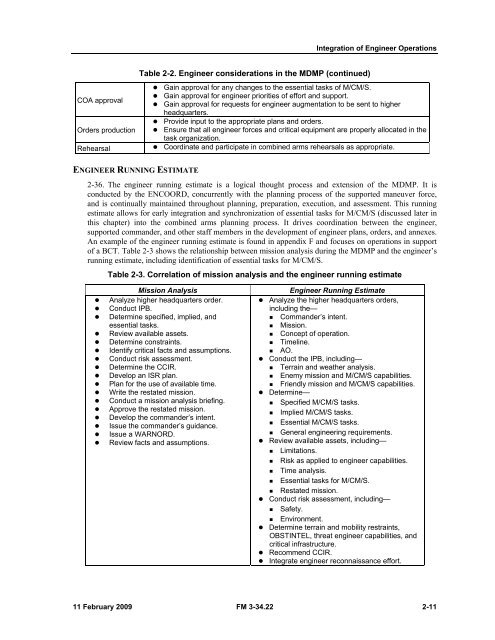FM 3-34.22 - Army Electronic Publications & Forms - U.S. Army
FM 3-34.22 - Army Electronic Publications & Forms - U.S. Army
FM 3-34.22 - Army Electronic Publications & Forms - U.S. Army
Create successful ePaper yourself
Turn your PDF publications into a flip-book with our unique Google optimized e-Paper software.
COA approval<br />
Orders production<br />
Rehearsal<br />
Table 2-2. Engineer considerations in the MDMP (continued)<br />
Integration of Engineer Operations<br />
� Gain approval for any changes to the essential tasks of M/CM/S.<br />
� Gain approval for engineer priorities of effort and support.<br />
� Gain approval for requests for engineer augmentation to be sent to higher<br />
headquarters.<br />
ENGINEER RUNNING ESTIMATE<br />
� Provide input to the appropriate plans and orders.<br />
� Ensure that all engineer forces and critical equipment are properly allocated in the<br />
task organization.<br />
� Coordinate and participate in combined arms rehearsals as appropriate.<br />
2-36. The engineer running estimate is a logical thought process and extension of the MDMP. It is<br />
conducted by the ENCOORD, concurrently with the planning process of the supported maneuver force,<br />
and is continually maintained throughout planning, preparation, execution, and assessment. This running<br />
estimate allows for early integration and synchronization of essential tasks for M/CM/S (discussed later in<br />
this chapter) into the combined arms planning process. It drives coordination between the engineer,<br />
supported commander, and other staff members in the development of engineer plans, orders, and annexes.<br />
An example of the engineer running estimate is found in appendix F and focuses on operations in support<br />
of a BCT. Table 2-3 shows the relationship between mission analysis during the MDMP and the engineer’s<br />
running estimate, including identification of essential tasks for M/CM/S.<br />
Table 2-3. Correlation of mission analysis and the engineer running estimate<br />
Mission Analysis Engineer Running Estimate<br />
� Analyze higher headquarters order.<br />
� Conduct IPB.<br />
� Determine specified, implied, and<br />
essential tasks.<br />
� Review available assets.<br />
� Determine constraints.<br />
� Identify critical facts and assumptions.<br />
� Conduct risk assessment.<br />
� Determine the CCIR.<br />
� Develop an ISR plan.<br />
� Plan for the use of available time.<br />
� Write the restated mission.<br />
� Conduct a mission analysis briefing.<br />
� Approve the restated mission.<br />
� Develop the commander’s intent.<br />
� Issue the commander’s guidance.<br />
� Issue a WARNORD.<br />
� Review facts and assumptions.<br />
� Analyze the higher headquarters orders,<br />
including the—<br />
� Commander’s intent.<br />
� Mission.<br />
� Concept of operation.<br />
� Timeline.<br />
� AO.<br />
� Conduct the IPB, including—<br />
� Terrain and weather analysis.<br />
� Enemy mission and M/CM/S capabilities.<br />
� Friendly mission and M/CM/S capabilities.<br />
� Determine—<br />
� Specified M/CM/S tasks.<br />
� Implied M/CM/S tasks.<br />
� Essential M/CM/S tasks.<br />
� General engineering requirements.<br />
� Review available assets, including—<br />
� Limitations.<br />
� Risk as applied to engineer capabilities.<br />
� Time analysis.<br />
� Essential tasks for M/CM/S.<br />
� Restated mission.<br />
� Conduct risk assessment, including—<br />
� Safety.<br />
� Environment.<br />
� Determine terrain and mobility restraints,<br />
OBSTINTEL, threat engineer capabilities, and<br />
critical infrastructure.<br />
� Recommend CCIR.<br />
� Integrate engineer reconnaissance effort.<br />
11 February 2009 <strong>FM</strong> 3-<strong>34.22</strong> 2-11

















